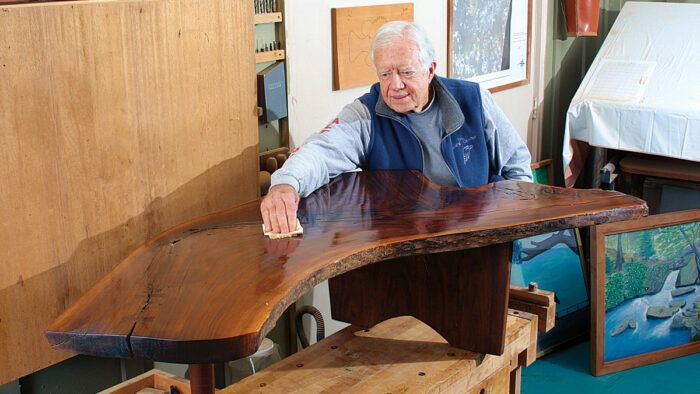Jimmy Carter on Woodworking
In this essay, the former president talks about his love of the craft, its beginnings, and some of his most recent projects.
Synopsis: When Jimmy Carter left The White House after the 1980 elections, his cabinet officers and staff acknowledged his love of woodworking with a gift certificate for tools. He calls it the most enjoyable gift he’s ever received. In this essay, the former president talks about his love of the craft, its beginnings, and some of his most recent projects.
Since I was a child, woodworking has played an important role in my life. It has given me a sense of belonging and a connection to a wide-ranging and dedicated fellowship. The feelings of continuity and timelessness that the craft has brought to me are most gratifying. I know that some of my pieces will be used for many generations in the future, and yet there is also a strong connection with the past. For instance, my most recent project was a large cabinet made of old pine boards from the first home built, in 1833, on our family farm. Each 11 ⁄4-in.-dia. doorknob contains 75 annual growth rings, so the trees were growing when Europeans were settling in this part of the country.
The workshop as a refuge
There was a real breakthrough in my life as a cabinetmaker when I was involuntarily retired from political life after the 1980 election. As we prepared to leave Washington, cabinet officers and White House staff had taken up a collection for my going-away present: enough to purchase a Jeep. I really didn’t need or want this gift, so I dropped a gentle hint that was eventually honored. With the already collected funds, they gave me a gift certificate for woodworking tools. It has been the most enjoyable gift I’ve ever received.
I spent most of 1981 at home in Plains, Ga., writing a memoir of my years in the White House. I put in several solid hours of writing before and after breakfast, and each day I walked the 20 steps to my woodshop for a restful vacation, studying my back issues of Fine Woodworking and Tage Frid’s instruction books. In those quiet moments, I practiced dovetail and finger joints, learned ornamental carving, and became more skilled with the router, lathe, and other power tools. Over the course of that year, we acquired a log cabin in the North Georgia mountains, and I built all of its furnishings—beds, chairs, tables, benches, cabinets, stools, and even the smaller items needed in the bathrooms.
Woodworking out of necessity
I grew up on a relatively isolated farm, long before we had electricity and when all the labor was by hand or with livestock. My father did the building and repairs, made many of our hand tools, and was a good cobbler and an expert blacksmith. As soon as I was physically able, he expected me to do my share of the work, and I was an eager student. I expanded my skills as a Future Farmer of America, and was required to make a few pieces of furniture, usually as gifts for my mother.
From Fine Woodworking #174
For the full article, download the PDF below:
Fine Woodworking Recommended Products

Sketchup Class

Blackwing Pencils

Circle Guide























Log in or create an account to post a comment.
Sign up Log in